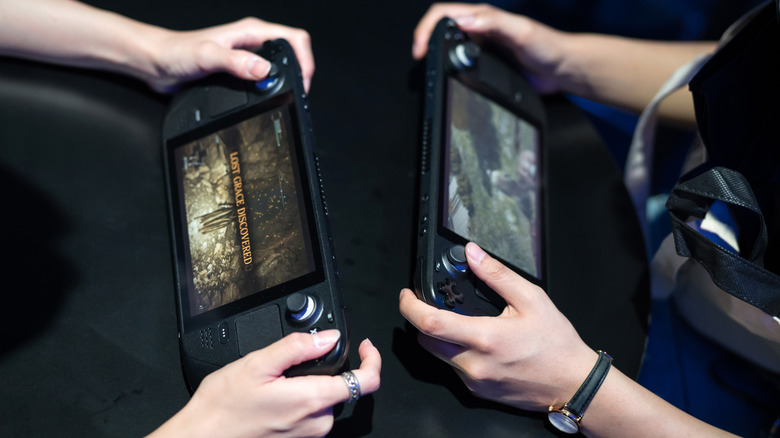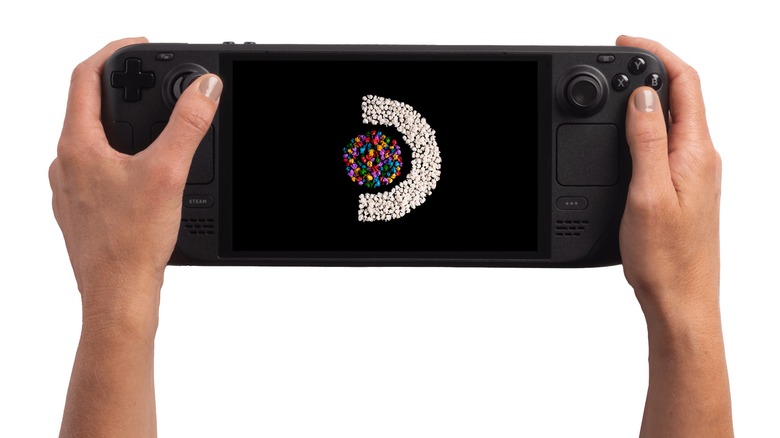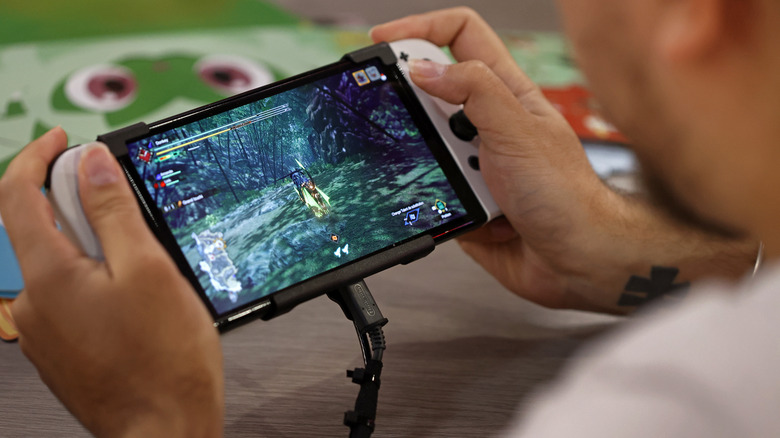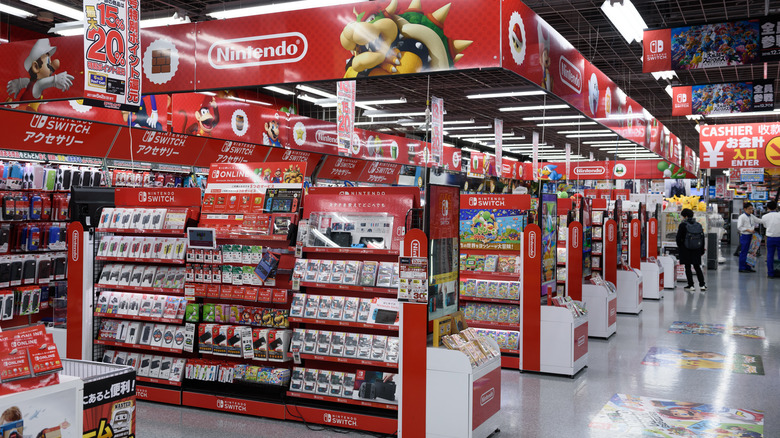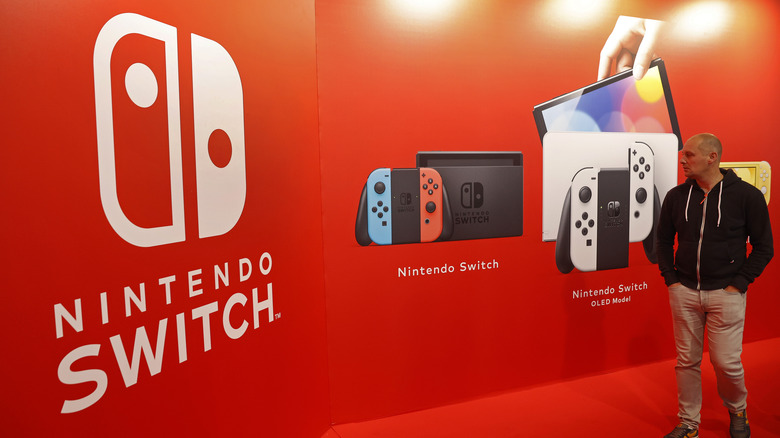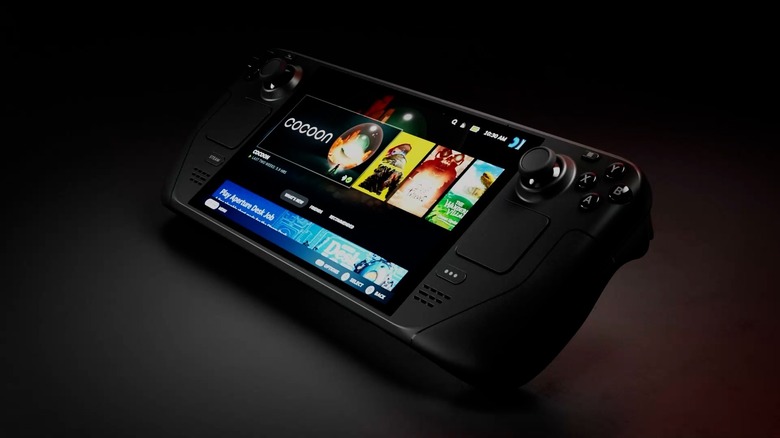Steam Deck OLED Vs. Nintendo Switch OLED: Which Handheld Suits Your Gaming Needs?
The face of handheld gaming has changed dramatically in recent years. Before, thanks to concerns about battery life, among other things, handhelds could be expected to be a few generations behind home consoles. That changed with the March 2017 release of the Nintendo Switch, which would serve as both Nintendo's new handheld and its new console, depending on whether or not it had the controllers attached or was docked. With a custom NVIDIA Tegra system on a chip powering it, the Switch has been able to be a fairly modern console. It's not as powerful as the last couple of generations of PlayStation and Xbox consoles, but it was still powerful enough to be a game changer.
The next evolution came in February 2022 with the release of Valve's Steam Deck, a handheld designed to play as many of the games available on the Steam PC gaming platform as possible. (Valve keeps track of which games have been verified to run well on Steam Deck.) This made a lot of major home console-quality AAA releases, at least the ones from third-party publishers that get PC ports, available on handhelds, making the Steam Deck a competitor to all three console companies.
Both Nintendo and Valve have since raised the stakes with versions of both consoles, adding upgraded versions with OLED displays in the form of the Switch OLED (released in October 2021) and the Steam Deck OLED (released in November 2023). They're both quality consoles, but how do you know which one is right for you? It depends on what you're looking for, so read on to better understand which one you should get.
What is the Steam Deck OLED?
In early 2022, Valve changed the face of handheld gaming by releasing the Steam Deck, which runs Steam OS, Valve's flavor of Linux. It is, plain and simple, a handheld with a 1200x800 display — and TV/monitor output using a USB Type-C to HDMI adapter — designed to play as many of the games that are available on Steam as possible, including plenty of the biggest multiplatform titles of recent years. The just-released Steam Deck OLED, though, improves on it in various ways, not just the obvious improvement in display quality from the original LCD version.
The Steam Deck OLED increases the display size from 7 inches to 7.4 inches while increasing both the refresh rate and brightness by 50% (to 90 Hz and 600 nits, respectively), moves from a 7nm custom AMD APU to a more efficient 6nm version, beefs up the battery size 25% to 50 Whr, and improves the Wi-Fi to faster Wi-Fi 6E. The Steam Deck OLED is available for $549 with 512GB of NVMe solid-state storage while upping the storage to 1TB increases the price to $649. If you're still interested in the LCD versions, the 256GB LCD model has had its price dropped to $399, while the other LCD models are being cleared out by Valve at $349 for the 64GB eMMC SSD model and $449 for the 512GB NVMe SSD model.
What is the Nintendo Switch OLED?
After 2012's Wii U console was a relative flop for Nintendo, the long-tenured Japanese video game powerhouse needed to make up lost ground in a big way with its next console release, and it did just that with the Switch in 2017. Docked, it was Nintendo's newest home console, taking over for the Wii U. On battery power with the controllers attached, it was Nintendo's newest handheld console, replacing the 3DS. And with a custom NVIDIA Tegra system on a chip powering the Switch, it was powerful enough to not be perceived as being left in the dust by Sony's PlayStation 4 or Microsoft's Xbox One, which were less than three-and-a-half years into their life cycle.
The Wii U had been hampered by a relatively barren game lineup and cross-platform games that, when they did make it over, were plagued with performance issues, such as "Batman: Arkham City." The Switch, on the other hand, has a much deeper lineup of games, both from Nintendo and third parties, including both exclusives and some major cross-platform titles, with generally positive reviews, making it a huge smash hit. The $299.99 Switch was joined by the portable-only $199.99 Switch Lite in September 2019, and eventually, the upgraded $349.99 Switch OLED —with a bigger, better display and double the onboard storage at 64GB — in October 2021.
In our Nintendo Switch OLED review from when it launched, we touted it as "an excellent purchase for first-time buyers" since it costs just $50 more than the LCD Switch. With its superior screen and kickstand, the review closed by noting that "your eyes, tabletops, and Smash Bros. opponents will thank you later."
Which has the better library of games?
Which semi-portable game console's game library appeals to you depends entirely on your personal preferences. If you're a huge fan of Nintendo's first-party games from the Mario, Donkey Kong, Kirby, Pokémon, "Legend of Zelda," or Metroid franchises, then the Switch is for you. If you want AAA titles that appear on other consoles, the Switch isn't quite as compelling, but it still has some solid options. The Switch has also gotten first dibs on titles like the last two games in the "No More Heroes" series, which began on the Nintendo Wii.
The Steam Deck, meanwhile, gives you access to the premier PC gaming store of the last two decades. This includes not just the best in PC exclusives and AAA cross-platform games that have PC ports but also some things that may surprise you if you haven't been paying attention to PC gaming.
Specifically, Sony now publishes what were previously PlayStation exclusives on PCs, including on Steam. It doesn't include the absolute latest and greatest PlayStation exclusives, as those have windowed exclusivity on Sony's consoles. But as of this writing, that library includes "Uncharted: Legacy of Thieves Collection," 2022's "God of War," "Ratchet & Clark: Rift Apart," "The Last of Us: Part I," and more.
Not only that, but you have access to older games not available on any actively supported console. Case in point: Steam has Ubisoft's Splinter Cell series, which hasn't seen a new title or even a port since 2013's "Tom Clancy's Splinter Cell: Blacklist" on the PlayStation 3, Xbox 360, Wii U, and PC. For overall depth and variety, the Steam Deck wins out here.
Hardware comparison
The Switch OLED and Steam Deck OLED hardware have as many similarities as they do differences. The displays are pretty close in terms of resolution, with the Steam Deck having just slightly higher resolution at 800p to the Switch's 720p. Valve's handheld also has a slightly larger screen at 7.4 inches compared to the Switch's 7.0 inches, and it also boasts a 90Hz refresh rate, 50% better than that of the Switch. The Steam Deck OLED display also outdoes the Switch's in another area — it supports high dynamic range color and contrast levels.
All told, the Steam Deck OLED outdoes the Switch OLED in terms of most hardware facets, as it should, given their relative price points. At 16GB, it has four times as much RAM as the Switch, and that RAM is also clocked at a much higher speed than what's in the Switch. The AMD APU that powers the Steam Deck OLED is, while not directly comparable to the Switch's NVIDIA Tegra system on a chip on paper since it's a different architecture, is still a much more potent piece of gaming hardware in practical terms.
The Steam Deck OLED also has a bigger battery, though the demands of its hardware make it so that it doesn't have better battery life, whereas the Switch is more reliable due to Nintendo's tighter controls. Besides battery life, the Switch's other big advantage is weighing about two-thirds of what the Steam Deck does.
The final verdict
As alluded to earlier, this is all a matter of personal preference in a way that it wouldn't be if we were comparing the new Steam Deck OLED to other handheld gaming PCs. The Switch has a deeper library than the previous modern-era Nintendo consoles, but it's still a library that primarily shows its value to existing fans of Nintendo's established properties. And if you're interested in major cross-platform titles, though the Switch gets some of them, they generally have technological sacrifices made to get them to work well on the ARM-based console.
That said, with its more consistent battery life and lighter weight, the Switch OLED is the more portable of the two consoles and comes at a lower price. Plus, it's not strictly a limited "Mario machine" in the way that the Wii U was, with Nintendo fans having plenty of games to keep them occupied if they're first picking up the Switch now. For someone who knows they want to play all of Nintendo's wares, it's the best choice.
The Steam Deck OLED, though, is a no-brainer if your priority is AAA blockbuster games from the past two decades. If you have anything specific in mind, it's best to check to see if it's been verified playable on the Steam Deck and, if so, how playable it is. (Some games require setup menu tweaks, while others may play well but have text that's illegibly small on the Steam Deck screen.)
Regardless, you get an absurdly deep library containing many of the best third-party games of the last three console generations and even some titles that had previously been Xbox or PlayStation exclusives. If that's what you want to play, then the Steam Deck OLED is for you.
